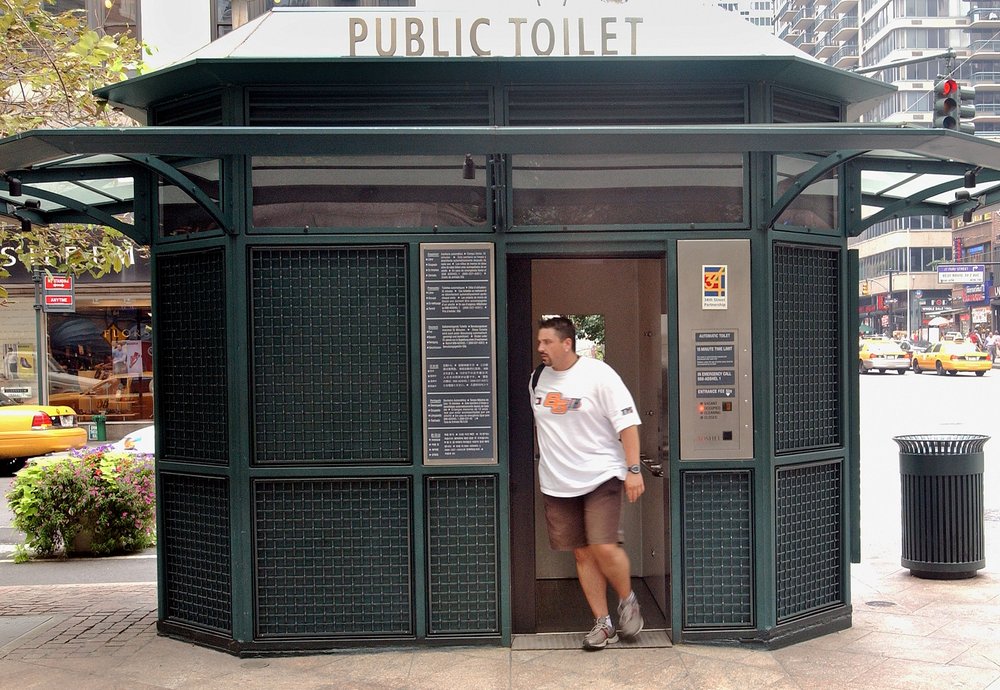When you gotta go: NYC Council vows to make it easier to find a public bathroom
April 10, 2025, 6 a.m.
A new bill would double the number of toilets across the city.

Places to go when you've got to go will double in New York City over the next decade, under a bill passed by the City Council Thursday.
NYC has among the fewest commodes per capita among large U.S. cities; a slew of city agencies operate 1,066 restrooms that are open to the public, or about one potty for every 7,800 residents.
The bill's sponsor, Councilmember Sandy Nurse said she wants to lower that ratio to ensure there’s one toilet for every 3,600 residents by 2035.
“It’s surprising that there isn't a bathroom master plan for the city, considering everything else has a master plan. Roads have plans, parks have plans, schools have plans," Nurse said. "But we don't plan for the fact that there are 8.2 million people living in the city, and every single one of those people has to relieve themselves throughout the day."
That’s why her bill requires the city to produce a report every four years for how they’ll bring more potties to the public, how much it’ll cost and how they’ll be kept clean and safe — as it works toward reaching 2,120 bathrooms in the next 10 years.
The push to level up the loos comes as private businesses, like Starbucks, are restricting bathroom use to paying customers, and as tourists are venturing out again after the pandemic. More public comfort stations would also bring particular relief to gig workers or homeless New Yorkers who don’t always have regular access to a bathroom.
“ You need to buy something to actually be able to use a bathroom, which, if you are on the street, it is very, very difficult,” said Milton Perez, who was homeless for five years, and now volunteers with VOCAL-NY, an advocacy group for low-income New Yorkers.
Last summer, Mayor Eric Adams announced plans to build or renovate 82 bathrooms over the next five years and released a digital map of open toilets. Nurse’s bill would expand on his initiative and ensure the city will maintain a mobile-friendly map that lists the hours a bathroom is open, whether it's ADA-accessible or if there’s a baby changing station, which most now have.
”The bathroom situation is critical,” said Charon Best, an organizer for the Carroll Gardens Association and former nanny. “ If the park or the playground doesn't have a bathroom, [nannies] sometimes change it on the table or on their lap.”
A traditional brick-and-mortar john can cost anywhere from $3 million-$5 million and take three to five years to be built. The Council bill recommends a faster way to boost bathrooms by opening the loos in public buildings, buying cheaper ready-made kiosk-like toilets or partnering with private businesses to lease their latrines.
Lifelong New Yorker Kim Lashley said she’s not a fan of the city’s public toilets and worries whether the new toilets could stay clean and safe.
“ I think they're most of the time disgusting,” she said. “ I just have a lot of trauma around public bathrooms, so unfortunately for me, it's gonna be very hard to persuade me.”
A City Council survey last year found more than two-thirds of the public bathrooms in parks were either closed or missing amenities like soap and toilet paper.
Nurse said it will be up to the city to make sure the bathrooms stay clean and safe. She said creating more bathrooms actually makes it safer for the public.
“ Not having to pop a squat between two cars and being able to do it in a proper facility that's clean is a public health measure, which is a public safety measure,” she said. “There are many people who are given criminal tickets like summonses and tickets and fines because they are forced to relieve themselves in public and can't help themselves.”
The NYPD issued more than 1,400 criminal summonses for public urination last year, data shows.
The Adams administration said it’s invested in increasing restrooms, capitalizing on high-tech and pre-fabricated options to lower costs.
“We also understand that not every neighborhood has the same demand, and if this bill becomes law, we must prioritize new public bathrooms where there is the most need,” mayoral spokesperson Liz Garcia said.
Australian tourist Phil Waugh wandered around the World Trade Center, one of three neighborhoods the city identified as having no public bathrooms. He said it was really hard to locate a latrine in the city that people can use without buying something.
Back home, he said, “there's one on nearly every corner … there's heaps in Melbourne.”
New York City unveils plan to solve its public bathroom emergency 1 in 10 NYC public restrooms are out of order